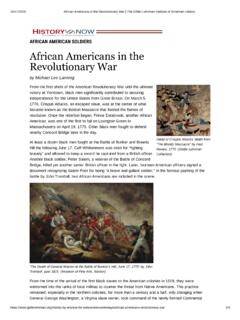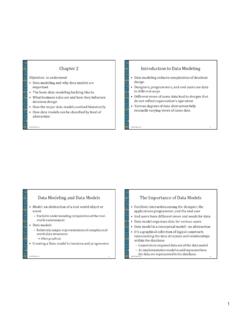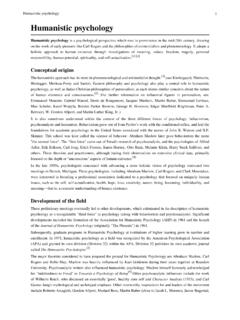Transcription of General Psychology 202 Motivation and Emotion
1 LP 9A Theories of Motivation 1 12/31/08 General Psychology 202 Motivation and Emotion Prologue: One Step at a Time Introduction: Motivation and Emotion Motivation Concepts and Theories Instinct theories: Inborn behaviors as motivators Drive theories: Biological needs as motivators Incentive Motivation : Goal objects as motivators Arousal theory: Optimal stimulation as a motivator humanistic theory: Human potential as a motivator Biological Motivation : Hunger and Eating Energy homeostasis: Calories consumed = calories expended Short-term signals that regulate eating Long-term signals that regulate body weight Excess weight and obesity: The epidemic Eating disorders: Anorexia and bulimia Psychological Needs as Motivators maslow s hierarchy of needs Deci and Ryan s self-determination theory Competence and achievement Motivation Emotion The functions of Emotion The subjective experience of Emotion The neuroscience of Emotion The expression of Emotion : making faces Theories of Emotion : Explaining emotions The James-Lange theory of emotions : Do you run because you re afraid?
2 Or are you afraid because you run? Cognitive theories of Emotion Closing Thoughts Application: Turning your goals into Reality LP 9A Theories of Motivation 2 12/31/08 Motivation Motivation : The biological, emotional, cognitive or social forces that activate and direct behavior. There are three basic characteristics associated with Motivation Activation (initiation of behavior) Persistence (continual efforts or determination) Intensity (strength of response) Theories of Motivation Instinct Theories Drive Theories Incentive Theories Arousal Theories humanistic Theories LP 9A Theories of Motivation 3 12/31/08 Instinct Theories Just as animals display instinctive behavioral patterns, such as migration or mating behaviors, human behavior is thought be motivated by innate instincts or genetic programming.
3 Instinct theories say that people are motivated to engage in certain behaviors because of evolutionary programming. Examples of Instincts Proposed by Instinct Theorists Instinct theory describes and labels behavior and relies on circular reasoning. While instinct theories seem logical, these labels and descriptions do not explain behavior. In addition, we don t have enough genes to account for every behavior and Motivation . People try to use instincts to explain ones behavior, but it rarely does. LP 9A Theories of Motivation 4 12/31/08 Drive Theories Behavior is motivated by the desire to reduce internal tension caused by unmet biological needs, such as hunger and thirst (p. 330). These unmet biological needs drive us to behave in certain ways to ensure survival.
4 Drives such as hunger and thirst arise from tissue deficits--when we are hungry, we are driven to eat. When we are thirsty, we are driven to drink. When a particular behavior reduces a drive, the behavior becomes reinforced when the same need state arises again. LP 9A Theories of Motivation 5 12/31/08 Our bodies biological systems are delicately balanced to ensure survival (page 330). Homeostasis is a state of internal physiological equilibrium that the body strives to maintain. For example, when you are hot, your body automatically tries to cool itself by perspiring. when you are cold, your body generates warmth by shivering. Physiological disruptions in homeostasis produce drives states of internal tension that motivate an organism to reduce this tension.
5 Where else have we heard the concept of homeostasis before? LP 9A Theories of Motivation 6 12/31/08 Incentive Theories Behavior is motivated by the pull of external goals and rewards such as rewards, money or recognition (page 331). This approach is based heavily on operant learning theory (behavior is based on the expectation of consequences such as reinforcements or punishments, Chapter 5), and hence testable. Reinforcements _____ behavior Punishments _____ behavior If we think we will be reinforced for the behavior, we are motivated to engage in that behavior. If we think we will be punished for the behavior, we are motivated to avoid that behavior. LP 9A Theories of Motivation 7 12/31/08 Arousal Theories Arousal theories are based on the observation that people find both very high levels of arousal and very low levels of arousal quite unpleasant.
6 When arousal is too low, we become motivated to increase arousal by seeking stimulating experiences When arousal is too high, we become motivated to reduce arousal by seeking a less stimulating environment. People are motivated to maintain an optimal level of arousal one which is neither too high or too low. LP 9A Theories of Motivation 8 12/31/08 LP 9A Theories of Motivation 9 12/31/08 humanistic Theories abraham maslow , a humanistic theorist, proposed a broad motivational model. He proposed that Psychology s other perspectives ignored a key human motive the desire to strive for personal growth. maslow s concept of self-actualization is hard to define, test and give too little weight to incentives. LP 9A Theories of Motivation 10 12/31/08 Table : maslow s Characteristics of Self-Actualized People Realism and acceptance Self-actualized people have accurate perceptions of themselves, others, and external reality.
7 They easily accept themselves and others as they are. Spontaneity Self-actualized people are spontaneous, natural and open in their behavior and thoughts. However, they can easily conform to conventional rules and expectations when situations demand such behavior. Problem centered Self-actualized people focus on problems outside themselves. They often dedicate themselves to a larger purpose in life, which is based on ethics or sense of personal responsibility. Autonomy Although they accept and enjoy other people, self-actualized individuals have a strong need for privacy and independence. They focus on their own potential and development rather than on the opinions of others. Continued freshness of appreciation Self-actualized people continue to appreciate the simple pleasures of appreciation of life with awe and wonder.
8 Peak experiences Self-actualized people common have peak experiences, or moments of intense ecstasy, wonder and awe during which their sense of self is lost or transcended. The self-actualized person may feel transformed and strengthened by these peak experiences. What do all of these theories of Motivation tell us about what motivates behavior? LP 9A Theories of Motivation 11 12/31/08 Hunger and Weight Regulation Many Americans are obsessed with achieving, or at least getting closer to, the socially desirable goal of thinness. Approximately one-third of all American women and one-fourth of all American males are trying to lose weight, and the weight -loss industry is a $33 billion a year enterprise. Based on what you have read in your text, what advice would you give to a friend who is trying to lose weight?
9 A recent finding indicates that 64% of American adults (115 million adults) are overweight or obese. This is a large increase in the last 50 years. Based on what you have learned on intelligence, explain why this gain in weight is not a genetic change in the American population, but most likely an environmental change? What factors lead a person to become overweight and obese? *(from Study Guide for Psychology by Cornelius Rea to Accompany Psychology by Hockenbury and Hockenbury, page 130): LP 9A Theories of Motivation 12 12/31/08 Hunger and Weight Regulation With an obsession with losing weight, consumers are easier to become persuaded by easy remedies such as: Weight-loss products such as Slimming Insoles that supposedly help you lose weight with every step The Svelt-Patch that melts away fat as you sleep Absorb-it-ALL Plus supplements promise you will lose three inches from your thighs.
10 A book, Dr. Hirsch s Guide to Scentsational Weight Loss, claims that inhaling certain odors will reduce hunger; a one-month supply of aroma pens (banana, green apple, and peppermint) sells for $45. Subliminal tapes to decrease the Motivation to eat. What motivates us to eat? LP 9A Theories of Motivation 13 12/31/08 Hunger and Weight Regulation Food intake: Does energy in = energy out? There are many biological, psychological and environmental factors that regulate our food intake. LP 9A Theories of Motivation 14 12/31/08 Short-term Signals that Regulate Eating Physiological Changes Blood Glucose Ghrelin (GRELL-in) LP 9A Theories of Motivation 15 12/31/08 Set-Point Theory / Settling Point Theory Many researchers believe that there is a set point a biologically determined standard around which body weight (fat mass) is regulated.
















